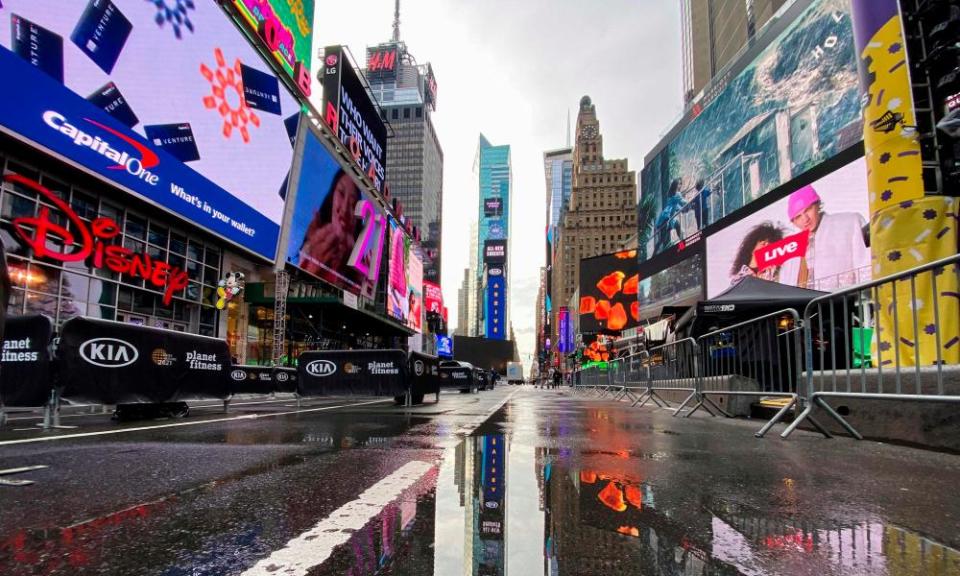Now the vaccine is here, I feel a sudden urge to make the most of lockdown

For the last week or so, a new type of text has been reliably coming in, in various states of excitement and relief, from friends – medics, teachers – sending photos of their vaccination certificates. Some received stickers after the jab, rather as one does after voting, bearing the legend: “I got my Covid-19 vaccine”. One wonders if, in the design departments of the large New York hospitals, there was a temptation to round out that statement with the exclamation mark we’re all surely feeling.
It is tremendously good news, obviously, that despite continuing problems with rollout, more than 370,000 people in New York have been vaccinated up until the end of Saturday. It also raises to the level of frank incredulity the cognitive dissonance of this bizarre period. While a tiny proportion of the population is now safe from the virus, in a single week in January, more than 3,000 people died of Covid in California alone and infection rates in the US – as in Britain – remain staggeringly high. A new president will soon be inaugurated, but the old one continues to foment trouble. Things are, assuredly, looking up. Meanwhile, members of the National Guard sleep on the floor of the Capitol.
As with every anticipated turning point of the last year, the hardest thing about all this is the waiting. How, exactly, is one to organise a response to the promise of better days, when the start line keeps being pushed back? It is striking, going over the past 12 months and with the anniversary of the first lockdown approaching, to recall how naive our expectations once were. I remember the shock, last spring, of understanding for the first time that nothing would be resolved by the summer; of realising, a few weeks later, that the schools wouldn’t go back full-time in the autumn; of coming to terms, slowly, with the realisation that despite the vaccine, the new year would bring no greater clarity.
Related: New York confirms state's first case of more contagious Covid strain
So here we are in January, a time of year, for all its grimness, usually dedicated to optimism and renewal. Relative to every other stage of the past 12 months, it should be possible to drum up some excitement, or at least a sense of expectant joy for the coming year. Our parents are being vaccinated. We may be able to travel again, modestly, this summer. Surely – surely – there will be no further disruption to the schools come the next academic year. By Christmas, won’t things be more or less back to normal?
The sense of suspended animation has either gone on too long, or the number of raised and dashed hopes been too high, that “Christmas 2021” does not seem like a reachable shore at this point, and none of these happy projections are landing. The current feeling, at least in New York, is that the holding pattern of deferred plans and reunions, of lightweight fear every time you consider taking the subway or hiring a babysitter, only to cancel because the risk seems too great, is one that will never be broken. Each peak and crisis will simply hand over to the next one. We will never be on the other side of this. We will remain in this situation for ever.
It’s a delusion, of course, galvanised by the fact that the adrenaline of the first waves has worn off and most of us are now running on empty. In the US, this feeling has only been hardened by the political crisis and the knowledge that, for all the relief of an incoming Biden administration, the forces unleashed by Trump aren’t going away. And while this year of the pandemic will, surely, be better than the last, it is perhaps easier to weather the first flush of a crisis than beat out time in its dying days. No matter how bad the implementation, the majority of the population will eventually receive the vaccine and normal life will return, a certainty that, paradoxically, replaces shock and resignation with what feels like a much harder line in impatience.
The only consolation, in keeping with the pious reflections of the first lockdown, is to make good use of this time, not by writing a novel or clearing your to-do list (although if you can, all power to you), but by somehow making a virtue of the drag of the days. In among the dreariness of this season of waiting, I find myself subject, occasionally, to sudden gusts of joy. Time has slowed to a crawl. Nothing is happening. My children are lately turned six, and if time continues to pass in this manner of a never-ending present, won’t turn seven for fully a decade. Seize it.
Emma Brockes is a Guardian columnist

 Yahoo Finance
Yahoo Finance 